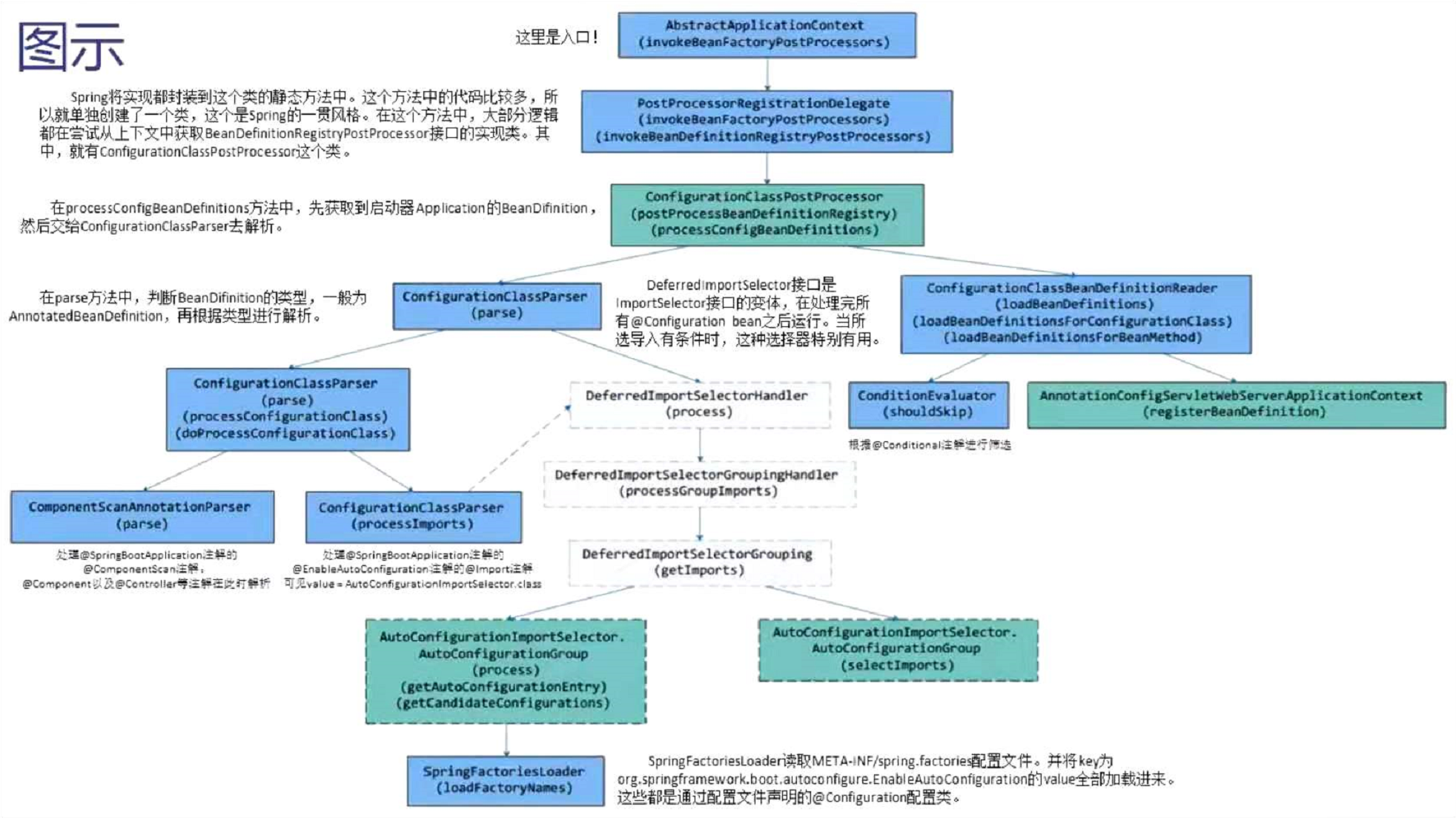# Spring Boot启动流程简析
# Spring Boot的设计方向
- 可以穿件独立的Spring应用程序,可以创建可执行的jars
- 内嵌tomcat或jetty等Servlet容器
- 提供“入门”依赖项,以简化构建配置。尽可能自动配置Spring和第三方库
- 提供可用于生产的功能,例如指标、运行状况检查和外部化配置
# Spring Boot注解
了解基本的启动注解
@Target(ElementType.TYPE)
@Retention(RetentionPolicy.RUNTIME)
@Documented
@Inherited
@SpringBootConfiguration
@EnableAutoConfiguration
@ComponentScan(excludeFilters = { @Filter(type = FilterType.CUSTOM, classes = TypeExcludeFilter.class),
@Filter(type = FilterType.CUSTOM, classes = AutoConfigurationExcludeFilter.class) })
public @interface SpringBootApplication {
...
AnnotationUtil.java,该类会一级一级往上找
- @SpringBootApplication
- @SpringBootConfiguration
- @Configuration
@Target(ElementType.TYPE) @Retention(RetentionPolicy.RUNTIME) @Documented @Configuration public @interface SpringBootConfiguration { ...
- @Configuration
- @EnableAutoConfiguration
@Import(AutoConfigurationImportSelector.class)
AutoConfigurationImportSelector是自动配置引入的选择器,它的任务是引入SpringBoot早已定义好的默认的一些Bean。包括SpringMVC涉及到的DispatcherServletAutoConfiguration和WebMVCAutoConfiguration(原本这些配置需要在bean.xml中手动配置)。——体现了Convention Over Configuration(约定优于配置)@Target(ElementType.TYPE) @Retention(RetentionPolicy.RUNTIME) @Documented @Inherited @AutoConfigurationPackage @Import(AutoConfigurationImportSelector.class) public @interface EnableAutoConfiguration { ...
- @ComponentScan(excludeFilters = { @Filter(type = FilterType.CUSTOM, classes = TypeExcludeFilter.class), @Filter(classes = AutoConfigurationExcludeFilter.class)}):
- 第一个为用户自定义的指定类型排除过滤器
- 第二个,当用户自定义了一个@Configuration配置类,并且在spring.factories配置文件中配置时,会被第二个过滤器排除
@Retention(RetentionPolicy.RUNTIME) @Target(ElementType.TYPE) @Documented @Repeatable(ComponentScans.class) public @interface ComponentScan { ...
- @SpringBootConfiguration
# ApplicationContext
了解Spring应用上下文接口
- 后面按顺序解读,主要需要关注SpringApplication.run()中的几个点:
- createApplicationContext:创建应用上下文
- prepareContext:向上下文注册一些bean
- refreshContext:如果是tomcat,则调用AnnotationConfigServletWebServerApplicationContext的refreshContext()刷新上下文
- 这一点在第三部分@Configuration注解中进行解读
- 启动类
@SpringBootApplication
public class SpbtApplication {
public static void main(String[] args) {
SpringApplication.run(SpbtApplication.class, args);
}
}
- SpringApplication.class构造方法
@SuppressWarnings({ "unchecked", "rawtypes" })
public SpringApplication(ResourceLoader resourceLoader, Class<?>... primarySources) {
this.resourceLoader = resourceLoader;
Assert.notNull(primarySources, "PrimarySources must not be null");
/**
*SpringApplication的run方法中的SpbtApplication.class传入这里
*/
this.primarySources = new LinkedHashSet<>(Arrays.asList(primarySources));
this.webApplicationType = WebApplicationType.deduceFromClasspath();
setInitializers((Collection) getSpringFactoriesInstances(ApplicationContextInitializer.class));
setListeners((Collection) getSpringFactoriesInstances(ApplicationListener.class));
this.mainApplicationClass = deduceMainApplicationClass();
}
- SpringApplication.class的run方法
public ConfigurableApplicationContext run(String... args) {
// 创建StopWatch对象,用于统计run方法启动时长
StopWatch stopWatch = new StopWatch();
// 启动统计
stopWatch.start();
ConfigurableApplicationContext context = null;
Collection<SpringBootExceptionReporter> exceptionReporters = new ArrayList<>();
// 配置headless 属性
configureHeadlessProperty();
// 获得SpringApplicationRunListener 数组
// 该数组封装于SpringApplicationRunListeners对象的listeners中
SpringApplicationRunListeners listeners = getRunListeners(args);
// 启动监听,遍历SpringApplicationRunListener数组每个元素,并执行
listeners.starting();
try {
// 创建ApplicationArguments对象
ApplicationArguments applicationArguments = new DefaultApplicationArguments(
args);
// 加载属性配置,包括所有的配置属性(如:application.properties中和外部的属性配置)
ConfigurableEnvironment environment = prepareEnvironment(listeners,
applicationArguments);
configureIgnoreBeanInfo(environment);
// 打印Banner
Banner printedBanner = printBanner(environment);
// 创建容器
context = createApplicationContext();
// 异常报告器
exceptionReporters = getSpringFactoriesInstances(
SpringBootExceptionReporter.class,
new Class[] { ConfigurableApplicationContext.class }, context);
// 准备容器,组件对象之间进行关联
prepareContext(context, environment, listeners, applicationArguments, printedBanner);
// 初始化容器
refreshContext(context);
// 初始化操作之后执行,默认实现为空
afterRefresh(context, applicationArguments);
// 停止时长统计
stopWatch.stop();
// 打印启动日志
if (this.logStartupInfo) {
new StartupInfoLogger(this.mainApplicationClass)
.logStarted(getApplicationLog(), stopWatch);
}
// 通知监听器:容器启动完成
listeners.started(context);
// 调用ApplicationRunner和CommandLineRunner的运行方法。
callRunners(context, applicationArguments);
} catch (Throwable ex) {
// 异常处理
handleRunFailure(context, ex, exceptionReporters, listeners);
throw new IllegalStateException(ex);
}
try {
// 通知监听器:容器正在运行
listeners.running(context);
} catch (Throwable ex) {
// 异常处理
handleRunFailure(context, ex, exceptionReporters, null);
throw new IllegalStateException(ex);
}
return context;
}
- AnnotationConfigServletWebServerApplicationContext.class通过idea参看该类类图
- 单看字段:最核心的是GenericApplicationContext.class的DefaultListableBeanFactory属性
- 作为BeanFactory的默认实现,DefaultListableBeanFactory实现了接口所有方法(需要做一些拓展)。GenericApplicationContext借助DefaultListableBeanFactory间接实现了折现接口。因为BeanFactory在getBean之前必须获取BeanDefinition(bean的定义对象),所有后续主要关注beanDefinitionMap这个属性。
- 单看字段:最核心的是GenericApplicationContext.class的DefaultListableBeanFactory属性
- SpringApplication.class的rprepareContext()
private void prepareContext(ConfigurableApplicationContext context, ConfigurableEnvironment environment,
SpringApplicationRunListeners listeners, ApplicationArguments applicationArguments, Banner printedBanner) {
context.setEnvironment(environment);
postProcessApplicationContext(context);
applyInitializers(context);
listeners.contextPrepared(context);
if (this.logStartupInfo) {
logStartupInfo(context.getParent() == null);
logStartupProfileInfo(context);
}
// Add boot specific singleton beans
ConfigurableListableBeanFactory beanFactory = context.getBeanFactory();
beanFactory.registerSingleton("springApplicationArguments", applicationArguments);
if (printedBanner != null) {
beanFactory.registerSingleton("springBootBanner", printedBanner);
}
if (beanFactory instanceof DefaultListableBeanFactory) {
((DefaultListableBeanFactory) beanFactory)
.setAllowBeanDefinitionOverriding(this.allowBeanDefinitionOverriding);
}
if (this.lazyInitialization) {
context.addBeanFactoryPostProcessor(new LazyInitializationBeanFactoryPostProcessor());
}
/**
*load方法传入的sources就是启动类传入run()的SpbtApplication.class,load()对这个类进行解析并添加到应用上下文中
*/
// Load the sources
Set<Object> sources = getAllSources();
Assert.notEmpty(sources, "Sources must not be empty");
load(context, sources.toArray(new Object[0]));
listeners.contextLoaded(context);
}
protected void load(ApplicationContext context, Object[] sources) {
if (logger.isDebugEnabled()) {
logger.debug("Loading source " + StringUtils.arrayToCommaDelimitedString(sources));
}
BeanDefinitionLoader loader = createBeanDefinitionLoader(getBeanDefinitionRegistry(context), sources);
if (this.beanNameGenerator != null) {
loader.setBeanNameGenerator(this.beanNameGenerator);
}
if (this.resourceLoader != null) {
loader.setResourceLoader(this.resourceLoader);
}
if (this.environment != null) {
loader.setEnvironment(this.environment);
}
loader.load();
}
# @Configuration注解
了解Spring Boot是如何处理@Configuration注解的
- refreshContext()中的refresh(),这个方法里就是主要的启动流程,该refresh()方法是AnnotationConfigServletWebServerApplicationContext继承的方法。如下是启动流程:
- 准备上下文环境
- 获取BeanFactory
- 为BeanFactory设置属性
- 交给子类去实现空方法
- 调用BeanFactoryPostProcessor
- invokeBeanFactoryPostProcessors()方法,正如方法名描述那样,是一个提供机会对BeanFactory进行一定的处理,这里一般都是注册BeanDefinition。
- 注册BeanPostProcessors
- 初始化Message资源
- 初始化事件广播器
- 交给子类去实现的空方法
- 注册事件监听器
- 初始化其他的单例Bean(非延迟加载的)
- 这里通过遍历BeanDefinition对象,生成真正的实例。依赖注入等初始化操作也在这里进行。
- 完成刷新过程,通知声明周期处理器lifecycleProcessor,同时发出ContextRefreshEvent通知finishRefresh().
@Override
public void refresh() throws BeansException, IllegalStateException {
synchronized (this.startupShutdownMonitor) {
// Prepare this context for refreshing.
prepareRefresh();
// Tell the subclass to refresh the internal bean factory.
ConfigurableListableBeanFactory beanFactory = obtainFreshBeanFactory();
// Prepare the bean factory for use in this context.
prepareBeanFactory(beanFactory);
try {
// Allows post-processing of the bean factory in context subclasses.
postProcessBeanFactory(beanFactory);
// Invoke factory processors registered as beans in the context.
invokeBeanFactoryPostProcessors(beanFactory);
// Register bean processors that intercept bean creation.
registerBeanPostProcessors(beanFactory);
// Initialize message source for this context.
initMessageSource();
// Initialize event multicaster for this context.
initApplicationEventMulticaster();
// Initialize other special beans in specific context subclasses.
onRefresh();
// Check for listener beans and register them.
registerListeners();
// Instantiate all remaining (non-lazy-init) singletons.
finishBeanFactoryInitialization(beanFactory);
// Last step: publish corresponding event.
finishRefresh();
}
catch (BeansException ex) {
if (logger.isWarnEnabled()) {
logger.warn("Exception encountered during context initialization - " +
"cancelling refresh attempt: " + ex);
}
// Destroy already created singletons to avoid dangling resources.
destroyBeans();
// Reset 'active' flag.
cancelRefresh(ex);
// Propagate exception to caller.
throw ex;
}
finally {
// Reset common introspection caches in Spring's core, since we
// might not ever need metadata for singleton beans anymore...
resetCommonCaches();
}
}
}
